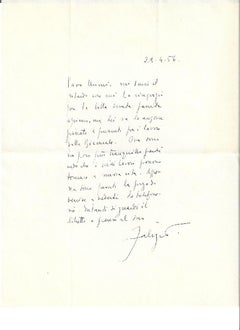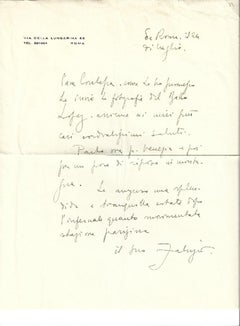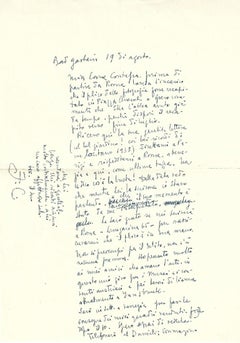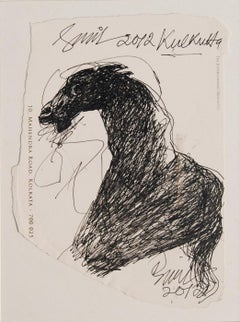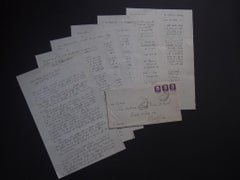Fabrizio Clerici More Art
to
5
Overall Width
to
Overall Height
to
5
4
1
5
5
5
4
19
317
231
170
117
5
Artist: Fabrizio Clerici
Autograph Letter Signed by Fabrizio Clerici - 1958
By Fabrizio Clerici
Located in Roma, IT
This is a Autograph Letter Signed by Fabrizio Clerici to the Countess A.L. Pecci-Blunt.
November 20th, 1958. Signed "Fabrizio". One page, double-sided. In Italian. Excellent conditi...
Category
1950s Modern Fabrizio Clerici More Art
Materials
Paper, Ink
Autograph Letter Signed by Fabrizio Clerici - 1956
By Fabrizio Clerici
Located in Roma, IT
This is a Autograph Letter Signed by Fabrizio Clerici to the Countess A.L. Pecci-Blunt.
April 4th, 1956. Signed "Fabrizio". One page, single-sided. In Italian. Excellent condition, ...
Category
1950s Modern Fabrizio Clerici More Art
Materials
Paper, Ink
Autograph Letter Signed by Fabrizio Clerici - 1957
By Fabrizio Clerici
Located in Roma, IT
This is a Fabrizio Clerici's Autograph Letter Signed, to the Countess and Patron of arts, Anna Laetitia Pecci-Blunt.
Rome, July 24th. Around 1957. Signed "Fabrizio". One page, singl...
Category
1950s Modern Fabrizio Clerici More Art
Materials
Paper, Ink
Fabrizio Clerici o i Fiori di Cenere - Rare Illustrated Book - 1976
By Fabrizio Clerici
Located in Roma, IT
Limited edition of 120 copies. Copy number 22 on Magnani di Pescia paper. Includes an original etching on Japon nacré paper numbered and signed by the atist Fabrizio Clerici.
Includ...
Category
1970s Modern Fabrizio Clerici More Art
Materials
Paper
A Journey to Austria - Autograph Letter Signed by Fabrizio Clerici - 1952
By Fabrizio Clerici
Located in Roma, IT
A Journey to Austria is the main content of this Autograph Letter by Fabrizio Clerici to the Countess and Patron of arts, Anna Laetitia Pecci-Blunt.
Bad Gastein...
Category
1950s Modern Fabrizio Clerici More Art
Materials
Paper, Ink
Related Items
Horse, Ink on Paper by Indian Modern Artist Sunil Das "In Stock"
By Sunil Das
Located in Kolkata, West Bengal
Sunil Das - Horse - 9 x 6 inches ( unframed size )
Ink on Paper, 2012
Inclusive of shipment in ready to hang condition.
Sunil Das ( 1939-2015) was a Master Modern Indian Artist fr...
Category
Early 2000s Modern Fabrizio Clerici More Art
Materials
Paper, Ink
$1,169 Sale Price
58% Off
H 9 in W 6 in D 1 in
English Modern Geometric Collage Purple, Gold, and Beige
Located in Houston, TX
Abstract modern collage of long geometric shapes in blue, brown, and beige, by artist Spe, 2000's . Signed. Displayed in a white mat with a gold border and fits a standard-size frame...
Category
Early 2000s Modern Fabrizio Clerici More Art
Materials
Paper
Rare 1950s Vintage Syndicated Ink Drawing Cartoon Strip Susie Q Smith Comic Art
Located in Surfside, FL
SUSIE Q. SMITH
Medium: Newspaper comics
Distributed by: King Features Syndicate
First Appeared: 1945
Creators: Linda and Jerry Walter
5.5 X 19.5
Dated August 13, 1954 in top right corner.
Like her contemporaries, Aggie Mack, Candy and Patsy Walker (before her conversion to a superhero), Susie Q. Smith was a female Archie-type — not exactly an imitator, because Archie, who had started only four years earlier, hadn't yet become popular enough to spawn imitators, but part of his genre. She attended high school, where her teachers often seemed unreasonable to her, interacted with the opposite gender in a typically adolescent way, and her parents didn't completely understand her. And she was cute and perky as only a teenage girl can be.
Susie was the star of a comic strip distributed by King Features, the biggest of the comic strip syndicates, whose other offerings have ranged from Jackys Diary to Prince Valiant. King launched the strip in both daily and Sunday form in 1945. Daily, she was only in a panel at first, but it expanded into a full, multi-panel strip on February 7, 1953. In a very odd turn of events, in 1953 the Walters chose to leave King Features behind and hitch their wagon at the McNaught Syndicate. The creators were Harold "Jerry" Walter and his wife, Linda. Jerry was also responsible for Jellybean Jones, who has nothing to do with Jughead Jones's young sister, a modern-day addition to the Archie cast of characters. Together, they did The Lively Ones during the 1960s. Though each was capable of doing both major jobs in comic strip production, their usual working method was for Jerry to dream up the ideas and write the dialog, while Linda did the artwork.
The Walters also collaborated on a series of Susie Q. Smith comic books for Dell Comics. Instead of reprinting newspaper strips, these ran new stories by the Walters. Between 1951 and '54, four issues were published as part of the Four Color Comics series, where many minor comic strips, including Dotty Dripple, Timmy and Rusty Riley had found a home. It had no other media spin-offs.
Susie Q. Smith had a respectable run in the newspapers, but it ended in 1959.
Jerry Walter (1915 - 2007) was an abstract expressionist artist whose output of energetic and colorful paintings were the products of the rich artistic milieu of post-war New York City. He was born Harold Frank Walter in Mount Pleasant, Iowa on November 25, 1915. After graduating from Colgate University in 1937, Walter moved to New York City, where he studied drawing and painting at the New School and the Art Students’ League. Before concentrating seriously on his art, he spent several years as a successful copywriter and idea man for the advertising agencies of J. Walter Thompson, McCann Ericson, and BBDO. During this time, he also worked as a syndicated cartoonist. Collaborating with his wife, Linda, his best-known series was Susie Q. Smith, which first appeared in 1945 and described as a “female Archie type.” Very popular, the cartoon was later the subject of a series of comic books published from 1951 to 1954. After serving in the United States Army for three years during World War II, Walter began to paint seriously. He ascribed his earliest artistic influence to Joan Miró, whose Dog Barking at the Moon (1926) he viewed when he was twelve, the year he published his first cartoon. Walter later wrote that jazz, “the first native expression of so-called modernism” was a strong influence on his work.
During the later 1940s, Walters spent time at the Research Studio in Maitland, Florida. Founded in 1937 by artist and architect J. André Smith and supported by the philanthropist Mary Curtis Bok, the Research Studio was a lively colony that hosted prominent artists, including Milton Avery, Ralston Crawford, and Doris Lee. While at the Studio, Walter’s work was purchased by Frank Crowninshield. A founding trustee of the Museum of Modern Art and editor of Vanity Fair, Crowinshield was a noted collector; his collection included important works by Pablo Picasso, Marc Chagall, Henri Matisse, Edgar Degas, George Bellows, and Pierre Bonnard. Returning to New York after his time at the Studio, Walter became an active member of the New York school of the abstract expressionist movement, and in the summer of 1956, Walter exhibited 13 paintings and a selection of drawings at New York’s Chase Gallery. The adroit manipulation of both color and composition evident in his work shows the influence of Abstract Expressionism, particularly Willem de Kooning, Arshile Gorky, and Hans Hofmann.
illustrator and female cartoonist Linda Walter was the talented female mind behind the beloved "Susie Q. Smith" comic strip. She played an instrumental role in shaping the cultural landscape through her vibrant illustrations. Known for the timeless charm of the "Susie Q. Smith" comic strip, Linda's artistry brought joy and laughter to countless readers during the 1950s and continues to resonate with fans across generations. She was part of the Woodstock artists community. from Women in Comics: Linda Walter was the artist of newspaper strip Susie Q. Smith, which was written by her husband, Jerry. It was syndicated by King Features Syndicate and ran from 1945 to 1959. The Walters also contributed original Susie Q. Smith stories to Dell's Four Color comic books from 1951 to 1954. From 1964-1965, they created a singled panel comic called The Lively Ones.
Vintage Golden Age of Comics era.
The Golden Age of Comic Books describes an era in the history of American comic books from 1938 to 1956. During this time, modern comic books were first published and rapidly increased in popularity. The superhero archetype was created. Between 1939 and 1941 Detective Comics (DC) and its sister company, All-American Publications, introduced popular superheroes such as Batman and Robin, Wonder Woman, the Flash, Green Lantern, Doctor Fate, the Atom, Hawkman, Green Arrow and Aquaman. Timely Comics, the 1940s predecessor of Marvel Comics, had million-selling titles featuring the Human Torch, the Sub-Mariner, and Captain America. Another notable series was The Spirit by Will Eisner.
Dell Comics' non-superhero characters (particularly the licensed Walt Disney animated-character comics) outsold the superhero comics of the day. The publisher featured licensed movie and literary characters such as Mickey Mouse, Donald Duck, Roy Rogers and Tarzan. Additionally, MLJ's introduction of Archie Andrews in Pep Comics #22 (December 1941) gave rise to teen humor comics, with the Archie Comics...
Category
1950s American Modern Fabrizio Clerici More Art
Materials
Paper, Ink
Black & White Collage on Board w. a Touch of Red
By (After) Robert Rauschenberg
Located in Hudson, NY
Really well done collage in black and white with a few subtle touches of deep red. Collage is done on a box board and ready to hang.
Category
20th Century Modern Fabrizio Clerici More Art
Materials
Paint, Paper, Glue, Board, Magazine Paper
$600 Sale Price
20% Off
H 24 in W 20 in D 1.88 in
Oceans Apart
By Angele LaSalle
Located in East Hampton, NY
fun with Color Theory
As seen at Art on Paper 2024 at The Mannix Project East Hampton NY
12"x12" (14"x14" framed) each
These come in a white frame.
Acrylic on Paper
Artist Statement...
Category
2010s American Modern Fabrizio Clerici More Art
Materials
Acrylic, Archival Paper
Vintage Golden Age Syndicated Ink Drawing Cartoon Strip Susie Q Smith Comic Art
Located in Surfside, FL
SUSIE Q. SMITH
Medium: Newspaper comics
Distributed by: King Features Syndicate
First Appeared: 1945
Creators: Linda and Jerry Walter
6.5 X 19.5
Like her contemporaries, Aggie Mack, Candy and Patsy Walker (before her conversion to a superhero), Susie Q. Smith was a female Archie-type — not exactly an imitator, because Archie, who had started only four years earlier, hadn't yet become popular enough to spawn imitators, but part of his genre. She attended high school, where her teachers often seemed unreasonable to her, interacted with the opposite gender in a typically adolescent way, and her parents didn't completely understand her. And she was cute and perky as only a teenage girl can be.
Susie was the star of a comic strip distributed by King Features, the biggest of the comic strip syndicates, whose other offerings have ranged from Jackys Diary to Prince Valiant. King launched the strip in both daily and Sunday form in 1945. Daily, she was only in a panel at first, but it expanded into a full, multi-panel strip on February 7, 1953. In a very odd turn of events, in 1953 the Walters chose to leave King Features behind and hitch their wagon at the McNaught Syndicate. The creators were Harold "Jerry" Walter and his wife, Linda. Jerry was also responsible for Jellybean Jones, who has nothing to do with Jughead Jones's young sister, a modern-day addition to the Archie cast of characters. Together, they did The Lively Ones during the 1960s. Though each was capable of doing both major jobs in comic strip production, their usual working method was for Jerry to dream up the ideas and write the dialog, while Linda did the artwork.
The Walters also collaborated on a series of Susie Q. Smith comic books for Dell Comics. Instead of reprinting newspaper strips, these ran new stories by the Walters. Between 1951 and '54, four issues were published as part of the Four Color Comics series, where many minor comic strips, including Dotty Dripple, Timmy and Rusty Riley had found a home. It had no other media spin-offs.
Susie Q. Smith had a respectable run in the newspapers, but it ended in 1959.
Jerry Walter (1915 - 2007) was an abstract expressionist artist whose output of energetic and colorful paintings were the products of the rich artistic milieu of post-war New York City. He was born Harold Frank Walter in Mount Pleasant, Iowa on November 25, 1915. After graduating from Colgate University in 1937, Walter moved to New York City, where he studied drawing and painting at the New School and the Art Students’ League. Before concentrating seriously on his art, he spent several years as a successful copywriter and idea man for the advertising agencies of J. Walter Thompson, McCann Ericson, and BBDO. During this time, he also worked as a syndicated cartoonist. Collaborating with his wife, Linda, his best-known series was Susie Q. Smith, which first appeared in 1945 and described as a “female Archie type.” Very popular, the cartoon was later the subject of a series of comic books published from 1951 to 1954. After serving in the United States Army for three years during World War II, Walter began to paint seriously. He ascribed his earliest artistic influence to Joan Miró, whose Dog Barking at the Moon (1926) he viewed when he was twelve, the year he published his first cartoon. Walter later wrote that jazz, “the first native expression of so-called modernism” was a strong influence on his work.
During the later 1940s, Walters spent time at the Research Studio in Maitland, Florida. Founded in 1937 by artist and architect J. André Smith and supported by the philanthropist Mary Curtis Bok, the Research Studio was a lively colony that hosted prominent artists, including Milton Avery, Ralston Crawford, and Doris Lee. While at the Studio, Walter’s work was purchased by Frank Crowninshield. A founding trustee of the Museum of Modern Art and editor of Vanity Fair, Crowinshield was a noted collector; his collection included important works by Pablo Picasso, Marc Chagall, Henri Matisse, Edgar Degas, George Bellows, and Pierre Bonnard. Returning to New York after his time at the Studio, Walter became an active member of the New York school of the abstract expressionist movement, and in the summer of 1956, Walter exhibited 13 paintings and a selection of drawings at New York’s Chase Gallery. The adroit manipulation of both color and composition evident in his work shows the influence of Abstract Expressionism, particularly Willem de Kooning, Arshile Gorky, and Hans Hofmann.
illustrator and female cartoonist Linda Walter was the talented female mind behind the beloved "Susie Q. Smith" comic strip. She played an instrumental role in shaping the cultural landscape through her vibrant illustrations. Known for the timeless charm of the "Susie Q. Smith" comic strip, Linda's artistry brought joy and laughter to countless readers during the 1950s and continues to resonate with fans across generations. She was part of the Woodstock artists community. from Women in Comics: Linda Walter was the artist of newspaper strip Susie Q. Smith, which was written by her husband, Jerry. It was syndicated by King Features Syndicate and ran from 1945 to 1959. The Walters also contributed original Susie Q. Smith stories to Dell's Four Color comic books from 1951 to 1954. From 1964-1965, they created a singled panel comic called The Lively Ones.
Vintage Golden Age of Comics era.
The Golden Age of Comic Books describes an era in the history of American comic books from 1938 to 1956. During this time, modern comic books were first published and rapidly increased in popularity. The superhero archetype was created. Between 1939 and 1941 Detective Comics (DC) and its sister company, All-American Publications, introduced popular superheroes such as Batman and Robin, Wonder Woman, the Flash, Green Lantern, Doctor Fate, the Atom, Hawkman, Green Arrow and Aquaman. Timely Comics, the 1940s predecessor of Marvel Comics, had million-selling titles featuring the Human Torch, the Sub-Mariner, and Captain America. Another notable series was The Spirit by Will Eisner.
Dell Comics' non-superhero characters (particularly the licensed Walt Disney animated-character comics) outsold the superhero comics of the day. The publisher featured licensed movie and literary characters such as Mickey Mouse, Donald Duck, Roy Rogers and Tarzan. Additionally, MLJ's introduction of Archie Andrews in Pep Comics #22 (December 1941) gave rise to teen humor comics, with the Archie Comics...
Category
1950s American Modern Fabrizio Clerici More Art
Materials
Paper, Ink
English Modern Geometric Collage Blues, Greens, and Yellows
Located in Houston, TX
Abstract modern collage of geometric shapes in blues, greens, and yellows, by artist Spe, 2000's. Signed. Displayed in a white mat with a gold border and fits a standard-size frame. ...
Category
2010s Modern Fabrizio Clerici More Art
Materials
Paper
1960s Italian Signed Abstract Painting
By Nino Caffè
Located in Roma, IT
Important signed Nino Caffè, painting on paper, mixed media.
“Vestizione di un pretino” (Vestments of a Young Priest)
Signed bottom center: Caffè.
Young ...
Category
1960s Modern Fabrizio Clerici More Art
Materials
Paper, Watercolor
Original Vintage Syndicated Ink Drawing Cartoon Strip Susie Q Smith Comic Art
Located in Surfside, FL
SUSIE Q. SMITH
Medium: Newspaper comics
Distributed by: King Features Syndicate
First Appeared: 1945
Creators: Linda and Jerry Walter
6.5 X 18
Like her contemporaries, Aggie Mack, Candy and Patsy Walker (before her conversion to a superhero), Susie Q. Smith was a female Archie-type — not exactly an imitator, because Archie, who had started only four years earlier, hadn't yet become popular enough to spawn imitators, but part of his genre. She attended high school, where her teachers often seemed unreasonable to her, interacted with the opposite gender in a typically adolescent way, and her parents didn't completely understand her. And she was cute and perky as only a teenage girl can be.
Susie was the star of a comic strip distributed by King Features, the biggest of the comic strip syndicates, whose other offerings have ranged from Jackys Diary to Prince Valiant...
Category
1950s American Modern Fabrizio Clerici More Art
Materials
Paper, Ink
Contemporary Hiroshi Yasukawa Signed Abstract Artwork
By Hiroshi Yasukawa
Located in Roma, IT
Modern Hiroshi Yasukawa Signed Abstract Painting
Important abstract minimalist work representing a circle crossed by a conceptual monochrome stripe typical of the great Japanese ar...
Category
1970s Modern Fabrizio Clerici More Art
Materials
Paper, Oil
$613 Sale Price
20% Off
H 2.68 in W 2.56 in D 0.04 in
It happened ... Paper, ink, pencil, 20x26 cm
Located in Riga, LV
It happened ...
Paper, ink, pencil, 20x26 cm
As a black and white comic, the absence of color allows the artist to focus on using shading, line work, and contrast to convey the narrative and emotions effectively. Black and white comics creates a distinct and dramatic atmosphere, emphasizing the story's mood and capturing the readers' attention.
Ivars Poikans 1952. Riga
Ivars Poikāns works in painting, graphics, book illustration, cinema art...
Category
1980s Modern Fabrizio Clerici More Art
Materials
Paper, Ink, Pencil
$424 Sale Price
20% Off
H 7.88 in W 10.24 in D 0.04 in
Rare 1950s Original Syndicated Ink Drawing Cartoon Strip Susie Q Smith Comic Art
Located in Surfside, FL
SUSIE Q. SMITH
Medium: Newspaper comics
Distributed by: King Features Syndicate
First Appeared: 1945
Creators: Linda and Jerry Walter
6.25 X 18.25
Like her contemporaries, Aggie Ma...
Category
1950s American Modern Fabrizio Clerici More Art
Materials
Paper, Ink
Previously Available Items
Nell'ora più bella - Autograph Letter Signed by Fabrizio Clerici - 1938
By Fabrizio Clerici
Located in Roma, IT
Nell'ora più bella (In the most beautiful hour) is a Autograph Letter Signed by Fabrizio Clerici to the Countess A.L. Pecci-Blunt.
Lucca, October 1938. Signed "Fabrizio Clerici". Si...
Category
1930s Modern Fabrizio Clerici More Art
Materials
Paper, Ink
H 10.83 in W 7.09 in D 0.04 in
Fabrizio Clerici more art for sale on 1stDibs.
Find a wide variety of authentic Fabrizio Clerici more art available for sale on 1stDibs. You can also browse by medium to find art by Fabrizio Clerici in paper, ink and more. Much of the original work by this artist or collective was created during the 20th century and is mostly associated with the modern style. Not every interior allows for large Fabrizio Clerici more art, so small editions measuring 8 inches across are available. Customers who are interested in this artist might also find the work of Alberto Martini, Filippo De Pisis, and Carlo Carrà. Fabrizio Clerici more art prices can differ depending upon medium, time period and other attributes. On 1stDibs, the price for these items starts at $334 and tops out at $557, while the average work can sell for $557.

